La Fanchonnette (the little Fanchette)
“The portrait of Madame Belmont who was judged to bear a strong resemblance”
The ladies shine brightest when it comes to serving dessert, and as it's a way for them to show off their delicate fingers and dexterity, they're often called upon for this service.- Grimaud de la Reynière, Manuel des Amphitryons, 1808
The 1938 Larousse Gastronomique’s definition for the fanchette or fanchonnette opens with “This cake, which used to be very fashionable, is now rarely made, which is a pity because it is excellent.” Prosper Montagné, author of the famed encyclopedia of gastronomy, what would become THE reference book for culinary terms, history, and technique, certainly hit the nail on the head with this one.
As I flipped through my collection of old and antique cookbooks looking for a recipe to write about, I came across a charming little pastry with a charming - and intriguing - name. La Fanchonnette. I questioned my French friends yet no one seems to have heard of it, this dessert that long ago fell out of fashion for some mysterious reason. And so of course I had to know more…
According to my Larousse, this “cake” begins with a thin layer of puff pastry - the same puff pastry one makes and uses for a galette des rois, meaning a multilayer puff pastry of 6 “turns” - which is pressed into one or several fluted pie tins or molds. The pastry is then filled with a cream similar to a crème pâtissière. The tart is then baked. Once cooled, the top is decorated with meringue piped on in points, dusted with sugar, then popped back in the oven to lightly color or caramelize the meringue. A single large gâteau of this sort is called a fanchette (originally called a fanchon); when made into small, individual tartlets, they are named fanchonnettes, or little fanchettes.
Skimming around the internet, as I spend most of my days doing when I’m not flipping through cookbooks, I discovered that Fanchon, an endearing nickname for Françoise, was a legendary street character made popular in the early 19th century on the stages of Paris. Alexandre Balthazar Laurent Grimod de La Reynière, lawyer, journalist, writer, and gourmand, captures it best in his 1806 Almanach des Gourmands: Serving as a Guide to Excellent Food "by an old amateur”:
“Les Fanchonnettes, which last year we included among our ‘New Discoveries’, continue to be a great success, and not a day goes by without M. Rouget (famous Parisian pastry chef, Rue de Richelieu N° 9) selling several dozen. It has not been forgotten that this pretty pastry is the emblem of the charming face and inimitable graces of Madame Henri-Belmont; of this amiable actress who makes new progress every day, and whose modesty regards the most striking marks of public favor as mere encouragement.”
Working our way back to his ‘New Discoveries’ section of the previous year’s edition, we find that he cannot stop enthusing over this treat, the pastry chef, or the actress:
“Des Fanchons et des Fanchonnettes : fanchons are a type of tart, a pastry case garnished (filled) with a crème anglaise and topped with meringue; we make them any size we wish. Les fanchonnettes are the same but much smaller, the diameter of a tartlet. One must have eaten fanchons, and especially fanchonnettes, to have an idea of their exquisiteness, their creaminess, and their lightness. They are, in fact, light, sweet pastries, the tastiest and the best that have ever been created. Much more delicate than frangipane, above and beyond all the other types of tartlets, worthy of the most discerning palates. It would have been enough to establish the reputation of an artist, but there was only one highly skilled artist who could have made such a discovery, with his many years experience and a profound knowledge of all the secrets of pastry…. M. Rouget is probably the only artist of the capital capable of imagining something of the kind…(And) one could only have given this delightful pastry a name that reminds us of the very charming actress who has created the role of Fanchon at the Théâtre de Vaudeville with so much success. And if it permissible to compare a lovely woman with a pastry, we can say it as connaisseurs of such delicacies, les fanchonnettes are an image of a fresh complexion, the delicacy of features, the velvet beauty of skin, that distinguishes the beauty of Madame Henri-Belmont. This description might very well touch on the common (or vulgar), but they exist nonetheless, and the more we think about it, the more convinced we are that fanchons and fanchonnettes could not be better or more appropriately named.”
And there you have it.
Fanchon La Vielleuse was a comedy in 3 acts by Jean-Nicolas Bouilly and Joseph Pain which opened at the Théâtre de Vaudeville in Paris in January 1805 with Mme. Sophie Belmont in the starring role. Fanchon represented all the pretty young women who roamed the streets of Paris in the 18th century playing a vielle, or hurdy-gurdy, their heads wrapped in a fanchon, a kerchief or scarf worn by women in place of a bonnet. And one Parisian pastry chef decided to create a pastry for the woman who brought this character to life on the stage (“on page 164 of the 2nd edition,” writes M. Grimod de La Reynière in yet another issue, “you will find a portrait of Madame Belmont who was judged to bear a strong resemblance, and a parallel between this charming woman and the fanchonnettes”)
Of course, who else but the famed and brilliant Marie-Antoine Carême to be the first to put such a pretty little thing as a fanchonnette in the pages of a cookbook? And devote an entire section in Le Pâtissier Parisien published in 1815 to it, barely ten years after the creation of the confection. And, of course, Carême couldn’t have just one single recipe for this pastry. The “king of chefs and the chef of kings” includes recipes for 8 variations of fanchonnettes, those filled with vanilla cream, almond milk cream, moka coffee cream, chocolate cream, hazelnut cream, and those with the addition of dried currants (one atop each meringue point) or pistachios (one layer of crème fanchonnette in which ground pistachios and candied citron (cédrat) are folded in and one layer of regular fanchonnette cream), and fanchonnettes in which the cream is replaced by apricot jam or marmalade.
Novelist Alexandre Dumas includes fanchonnettes - neither a fanchon nor a fanchette to be seen - in his Grand Dictionnaire de Cuisine at the other end of the century, in 1873, “borrowing the principle formulas” for this entremets de pâtisserie from the “author of Les Memoirs de la Marquise de Créquy” - referring to Pierre-Marie-Jean Cousin, Count of Courchamps, I discover after much frustration and research - adding “of course, one cannot find elsewhere a gourmet more familiar with all the chatter of the last century and all the delights and delicacies of this one.” The “formulas” - recipes, of course - that Dumas includes in his dictionary, are the same found in and borrowed from Courchamps’ 1839 Néo-physiologie du Goût, par ordre alphabétique, Dictionnaire Général de la Cuisine Française (Neo-physiology of Taste, in alphabetical order, General Dictionary of French Cuisine) which are actually the recipes word for word from Carême’s Le Pâtissier Parisien. Apparently Dumas never read Carême, unwittingly keeping his fanchonnettes alive after 60 years.
That same year, 1873, Jules Gouffé slightly changes and reduces the number of recipes for fanchonnettes in Le Livre de Pâtisserie. He begins by including a general recipe for a crème à fanchette et à fanchonnette beginning with 12 egg yolks (!!!) and then has recipes for the now-traditional fanchonnettes with vanilla cream, fanchonnettes aux pistaches (one fills the pastry shell with a chocolate fanchonnette cream, the meringue is then thickly and smoothly spread on top of each tartlet which is then crowned with a rosace of beautiful green pistachios sliced into “leaves” - “this fanchonnette,” he writes, “should be white and the pistachios a beautiful green” - fanchonnettes demi-deuil or half-mourning (the cream is prepared with lemon sugar and a dried currant is placed atop each meringue point), and cherry fanchonnettes (the cream is flavored with orange flower water and a single candied cherry is placed in the center of each tartlet within the ring of meringue points).
Strangely (and here is my little odd and humorous medical trivia of the day) one finds a simple entry for fanchonnettes in Le Cuisinier et le Médecin et le Médecin et le Cuisinier ou Le Cuisinier Médecin et le Médecin Cuisinier (The Cook and the Doctor and the Doctor and the Cook or the Cook Doctor and the Doctor Cook, the Art of Maintaining and Restoring One’s Health Through Proper Nutrition which is the absolute best title of a book ever!), a book published by the Society of Doctors, Chemists, Cooks and Catering Officers in 1855. One is warned that “this excellent dessert pastry” which comes in several flavors, “much like all other pastries, is best eaten sparingly, especially for those with weak, delicate stomachs.” Of course….
The popularity of the fanchonnettes, even more so than the larger sized fanchons or fanchettes which seem to quickly disappear from the pages of cookbooks, continued through the 19th century. And as the larger tarts have disappeared, so have the selection of several flavor and style variations on the fanchonnette; cookbooks have rather quickly and suddenly been whittled down to one single recipe. André Viard seems to be the earliest author to include only one recipe for this confection in his Le Cuisinier Royal in 1822, a fanchonnette with a cream flavored with almonds and lime zest. M. Burnet has this same recipe in his 1836 Dictionnaire de Cuisine et Économie, and for a culinary dictionary he only defines fanchonnette as “pastry”.
Louis Bailleux’ Le Pâtissier Moderne of 1856, Gustave Garlin’s 1889 Le Pâtissier Moderne, and Pierre Lacam’s Le Mémorial Historique et Géographique de la Pâtisserie of 1900 each have only a single recipe for the fanchonnette, the first with a vanilla cream and the meringue styled into a bell shape, Garlin’s using a cream flavored with orange flower water and the meringue decorated with jam, and Lacam simply decorating a plain fanchonnette with chopped almonds, his recipe reduced to a mere 2 sentences. We are beginning to see that the style of the tartlet matters rather than the specific flavor, giving pastry chefs’ imagination free rein.
And then the fanchonnette begins to disappear from both the pages of cookbooks and the French memory. I suspect that the cause for the fading away of M. Rouget’s “exquisite” pastry, “the tastiest and the best that have ever been created” might very well be that the fanchonnette always remained a pastry chef’s pastry, it never seemed to have crossed over into a home baked good made for the family. The fanchonnette does not seem to appear in a single cookbook written for the home cook and baker, a cookbook of la cuisine familiale or family-style cooking; I did find it in Austin de Croze’s 1928 Les Plats Régionaux de France, a book of regional and local specialties with the fanchonnette curiously showing up as a specialty of Bordeaux, and in Henri-Paul Pellaprat’s 1936 L’Art Culinaire Moderne and his 1937 Desserts, and while these latter 2 books were written with a home cook in mind, M. Pellaprat, co-founder of Le Cordon Bleu cooking school in Paris, was probably shooting high, aiming at a certain level of expertise in the kitchen. Could it be because both puff pastry and meringue, but mostly puff pastry, were not commonly or easily made in a humble family kitchen? French home cooks and bakers, we know, make simple, plain, homey treats, purchasing fancier, more complicated desserts at their local pastry shop when the occasion calls for one.
Our answer might very well lie with one M. Belon, pastry chef in the service of a ‘Cardinal C’, who wrote Le Pâtissier National et Universel in 1836. His book, as he claims in the introduction, “contains the methods and techniques employed by the most celebrated pastry chefs both French and foreign” with recipes “for pastry shops, great houses, and grand ornamental or decorative pieces.” Belon includes a master recipe for fanchonnette and then at the end of the book includes a list of flavor variations, borrowed from M. Carême’s Le Pâtissier Royal Parisien, which can “serve as a guide to practicians (of the pastry arts) too shy to create but skilled enough to follow the indications given by the grand master.” We are now sure that fanchonnettes are and always were considered a confectionary reserved for the pastry chef. And evidently was left behind to make way for new creations. The fanchonnette simply went out of style.
By the end of the century, the word fanchonnette had come to have a culinary meaning of its own, coming from but separate from the tart. The January 1895 issue of L’Art Culinaire, the magazine of the Society of French Chefs, contains a recipe for petits soufflés d’Égrefin fumés (égrefin being a variation of églefin or aiglefin or haddock) or small smoked haddock soufflés in which “using a piping bag or paper cone, place your filling onto your little tarts to form a small "fanchonnette", i.e. a graded cone shape”, in the same way that the meringue was decoratively piped onto a fanchonette, not unlike a meringue-topped lemon tartlet.
Fanchonnette also began to be used more generally for a panoply of little decorative pastries; in the L’Art Culinaire issue of January 1, 1910, there is a mention of fanchonnettes glacées described as “small iced biscuits, strawberry or praline flavors, packaged in adorable scalloped, heart-shaped boxes.” The 1984 edition of Larousse Gastronomique adds “we also give the name ‘fanchonnettes’ or ‘fanchette’ to a variety of petits fours: nougat barquette (a small boat-shaped tart) filled with hazelnut pastry cream and iced with coffee fondant; a macaron filled with strawberry buttercream and iced with rose fondant.” And in 1904, the Badie sisters of Bordeaux, chocolate and candy makers, introduced a coffee-filled caramel candy and baptized it La Fanchonnette Bordelaise.
The fanchonnette. A pretty little, creamy, elegant dessert then faded away, was replaced by pastry chefs across France with other things, each new confection having its own era of glory. The fanchonnette has been forgotten by the French, and as Prosper Montagné wrote in 1938, it is a pity because it is indeed excellent. Granted, it is somewhat fiddly and time consuming to make, but for a special occasion it is worth it.
Vanilla or Coffee Fanchonnettes
Using cornstarch instead of flour makes a lighter pastry cream. While the puff pastry crusts are delicious, I prefer the fanchonnettes made with regular pâte brisée or plain pie crust; it was also fairly common to find this in 19th century cookbooks, so we’re still staying traditional with this. The only warning is that they are a little more difficult to remove from the tartlet tins/molds as they risk breaking or crumbling.
You will need about 8 to 9 ounces (230 to 250 grams) all-butter puff pastry, homemade or store bought.
Or
Pâte Brisée (plain pie crust)
Make your own pâte brisée with 1 3/4 cups (245 grams) flour, 3/4 teaspoon salt, 1/2 teaspoon sugar blended together in a large bowl. Rub in 12 1/2 tablespoons (180 grams) unsalted butter until it resembles damp sand and there are no large chunks of butter left. Using a fork, stir in 6 tablespoons cold water until a dough forms. Knead just until homogeneous and smooth on a floured work surface, adding more flour if needed. Roll out very thinly, line the tins or molds, then refrigerate for about 15 or 20 minutes before lining and prebaking.
Vanilla Pastry Cream
1 cup (250 ml) milk (I use 2% low fat) + ⅞ cup (200 ml) heavy cream or 1 ⅞ cups (450 ml) whole milk
1 small vanilla bean (½ large bean), split down the center, seeds scraped and reserved or 1 ½ teaspoons pure vanilla extract
3 large egg yolks
¼ cup + 2 tablespoons (75 grams) granulated sugar
2 tablespoons cornstarch
⅛ teaspoon ground nutmeg, optional
Coffee Pastry Cream (just the addition of espresso powder makes this cream much less sweet than the vanilla)
1 cup (250 ml) milk (I used 2% low fat) + 7/8 cup (200 ml) heavy cream or 1 7/8 cups (450 ml) whole milk
3 ½ teaspoons instant espresso powder
3 large egg yolks
¼ cup + 2 tablespoons (75 grams) granulated sugar
2 tablespoons cornstarch
½ teaspoon vanilla extract
Meringue
3 large egg whites
1 cup + 2 tablespoons (125 grams) granulated sugar
Powdered/confectioner’s sugar for dusting meringue, optional but traditional
Lightly toasted slivered almonds for garnish, optional
Prepare the vanilla pastry cream:
Place the milk or the milk and cream in a small to medium saucepan with the vanilla bean and the scraped seeds. Very gently heat the milk through just until warm; turn off the heat and allow the vanilla to infuse the milk/cream for about 15 to 30 minutes. At the end of this time and as you begin to prepare the pastry cream, remove the vanilla bean and discard. If using liquid vanilla extract you can skip this step.
In a medium-sized saucepan, gently whisk the egg yolks with the sugar and cornstarch, adding about half the milk/cream in a slow stream while you whisk the mixture until blended and smooth. Cook this gently over very low heat, whisking constantly, for 5 minutes until any lumps have been dissolved and the mixture is beginning to thicken. Pour in the rest of the milk/cream as you whisk, adding the vanilla extract and the nutmeg if using; continue to whisk constantly over low heat until thick and creamy and very smooth, about 5 to 6 minutes. The custard should coat a spoon.
Transfer the cream immediately to a glass/Pyrex measuring cup or bowl, and allow to cool for about 30 minutes, continuing to give the custard a good vigorous whisk occasionally so it doesn’t form a skin.
For the coffee pastry cream, place the milk and cream in the small saucepan with the espresso powder; heat over very low heat just until warm through, stir to blend, then remove from the heat and allow to infuse for 15 to 30 minutes. Add the vanilla extract with the second half of the espresso milk/cream while cooking. Follow the rest of the directions for the vanilla pastry cream.
Preheat the oven to 350°F (180°C). Place 6 small tartlet tins - each about 3 1/2-inches (9 cm) in diameter on a baking or cookie sheet. Butter the bottoms and sides of the tins. Line each tin with a thin round of puff pastry (or regular pie pastry/pâte brisée), gently pressing the pastry dough in to fit the tin/mold; trim. It’s best to refrigerate them for 15 minutes or so to firm if the dough is soft.
Gently prick the bottom of each pastry crust with a fork. Place a square of parchment paper on each crust and fill with dried beans to weigh the pastry crust down while baking; bake in the preheated oven for about 10 minutes. Remove from the oven, carefully lift each square of parchment paper and dump the beans back in the jar to use at another time. Discard the parchment. Carefully press each crust down - pressing the sides of the crust, as well - to press out the air. Allow the crusts to cool. If you like, you can pop each crust out of its tin then replace it just to loosen the crusts before baking with the pastry cream.
Once the crusts and the custard/pastry cream are mostly cooled, spoon the pastry cream into each crust, dividing equally and filling each tartlet shell up to the rim with the cream.
Bake in the preheated oven for about 15 minutes until the cream has “dried” - you’ll see that the top of the cream has formed a “skin” and is no longer shiny. Remove from the oven and allow to cool.
As the tartlets are cooling, I prefer to stick them in the refrigerator for a bit to cool completely to firm them more before carefully lifting them out of the tins/molds before topping with the meringue. Once removed from the tins/molds, stick them back in the refrigerator if not completely cool.
Prepare the meringue.
Using VERY clean beaters, beat the egg whites with an electric mixer on low speed for 30 seconds then gradually increase the speed to high and continue beating until the whites are no longer foamy and are soft but opaque. While continuing to beat on high speed, gradually pour in the sugar and continue to beat until the meringue is thick and dense. Stiff peaks will hold.
Carefully spread a tablespoon or so of the meringue over the top of the custard/pastry cream all the way to the edges to cover even the crust. Using a long-bladed icing or offset spatula works best.
Using a pastry bag with a regular round tip, pipe on smooth points of meringue to cover the fanchonnettes.
Lightly color or caramelize the meringue under a broiler or using a kitchen torch or chalumeau, being very careful not to burn the meringue.
Decorate as you like.
Thank you for subscribing to Life’s a Feast by Jamie Schler where I share my recipes, mostly French traditional recipes, with their amusing origins, history, and anecdotes. I’m so glad that you’re here. You can support my work by sharing the link to my Substack with your friends, family, and your social media followers. If you would like to see my other book projects in the making, read my other essays, and participate in the discussions, please upgrade to a paid subscription.





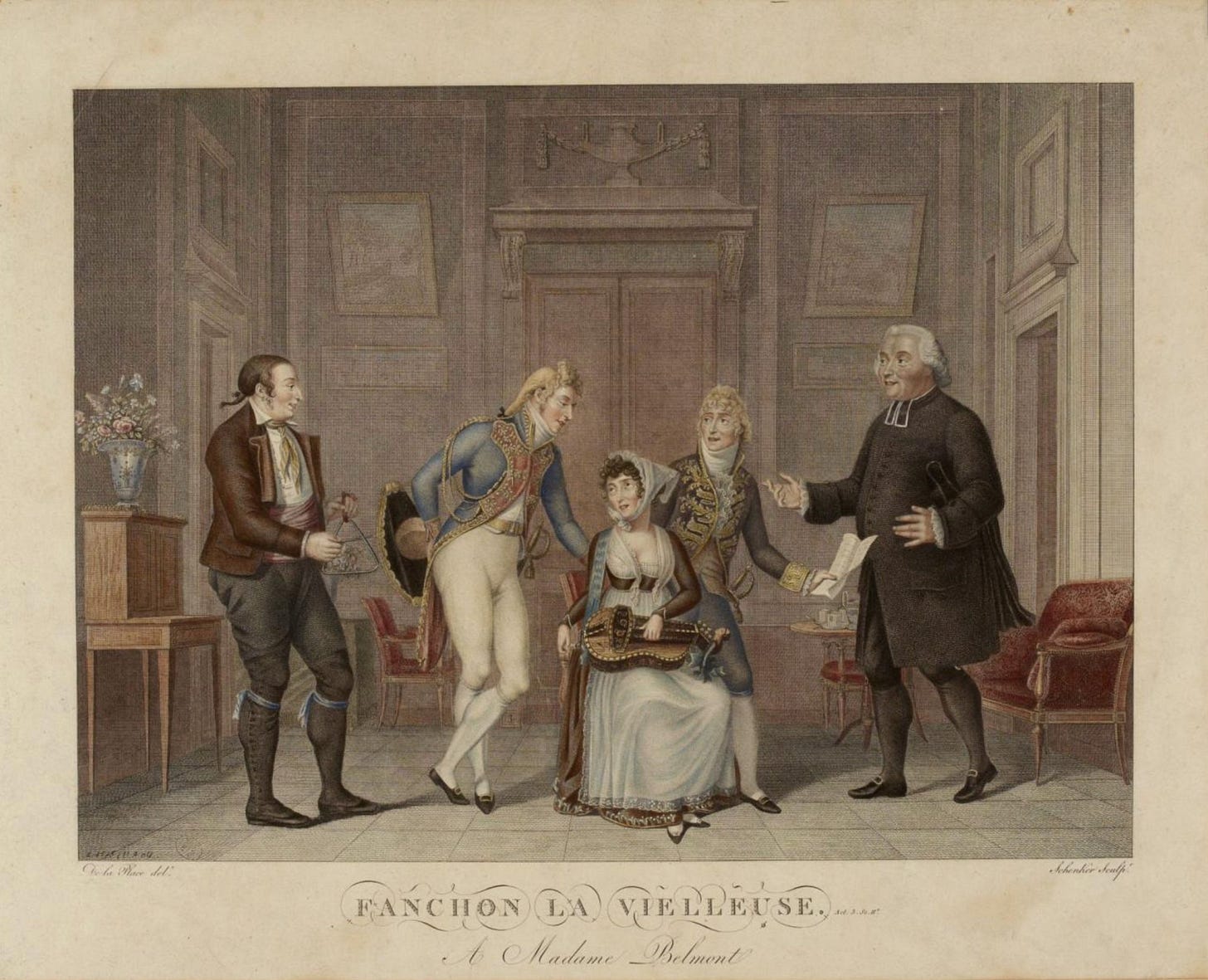

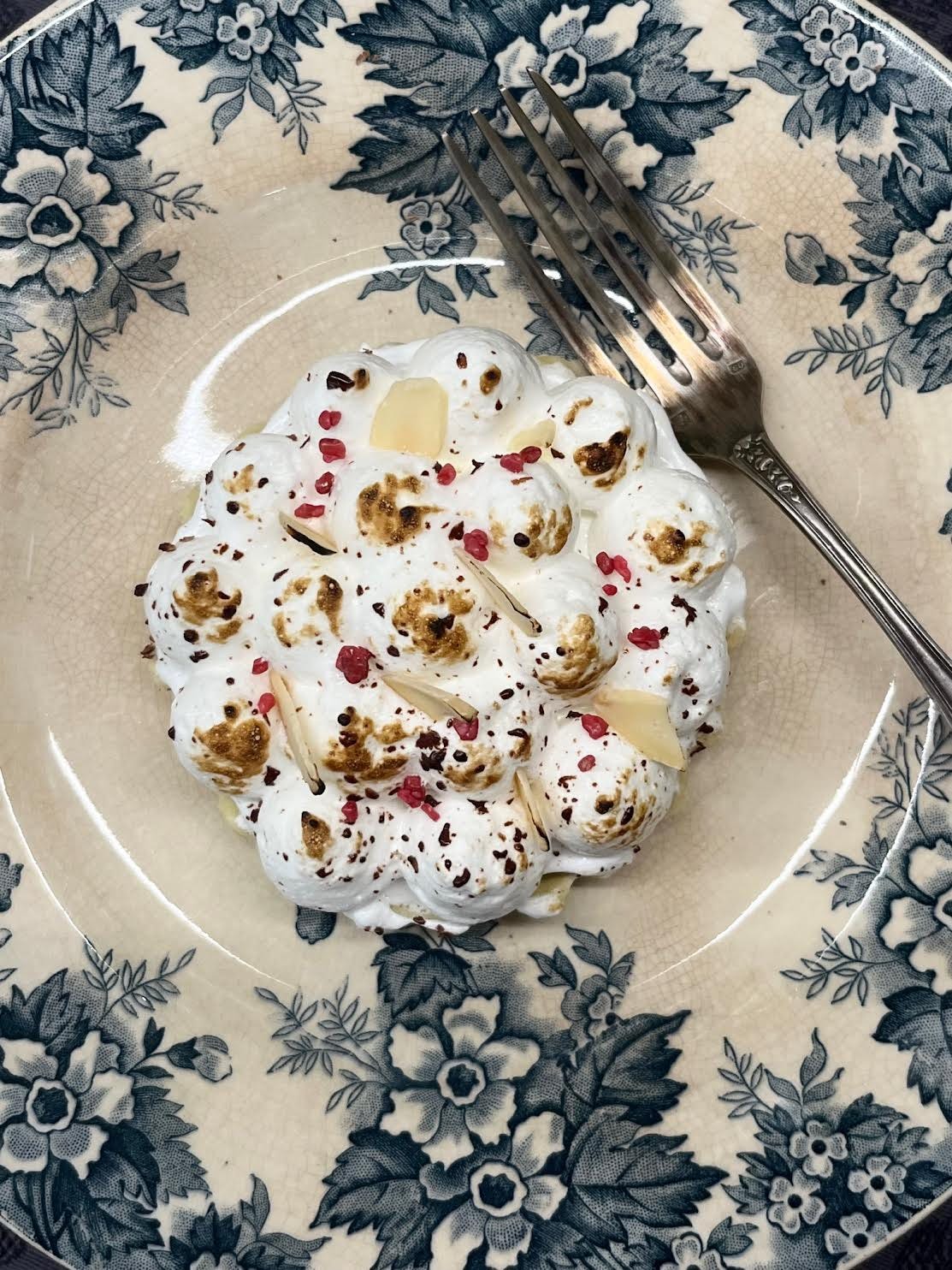


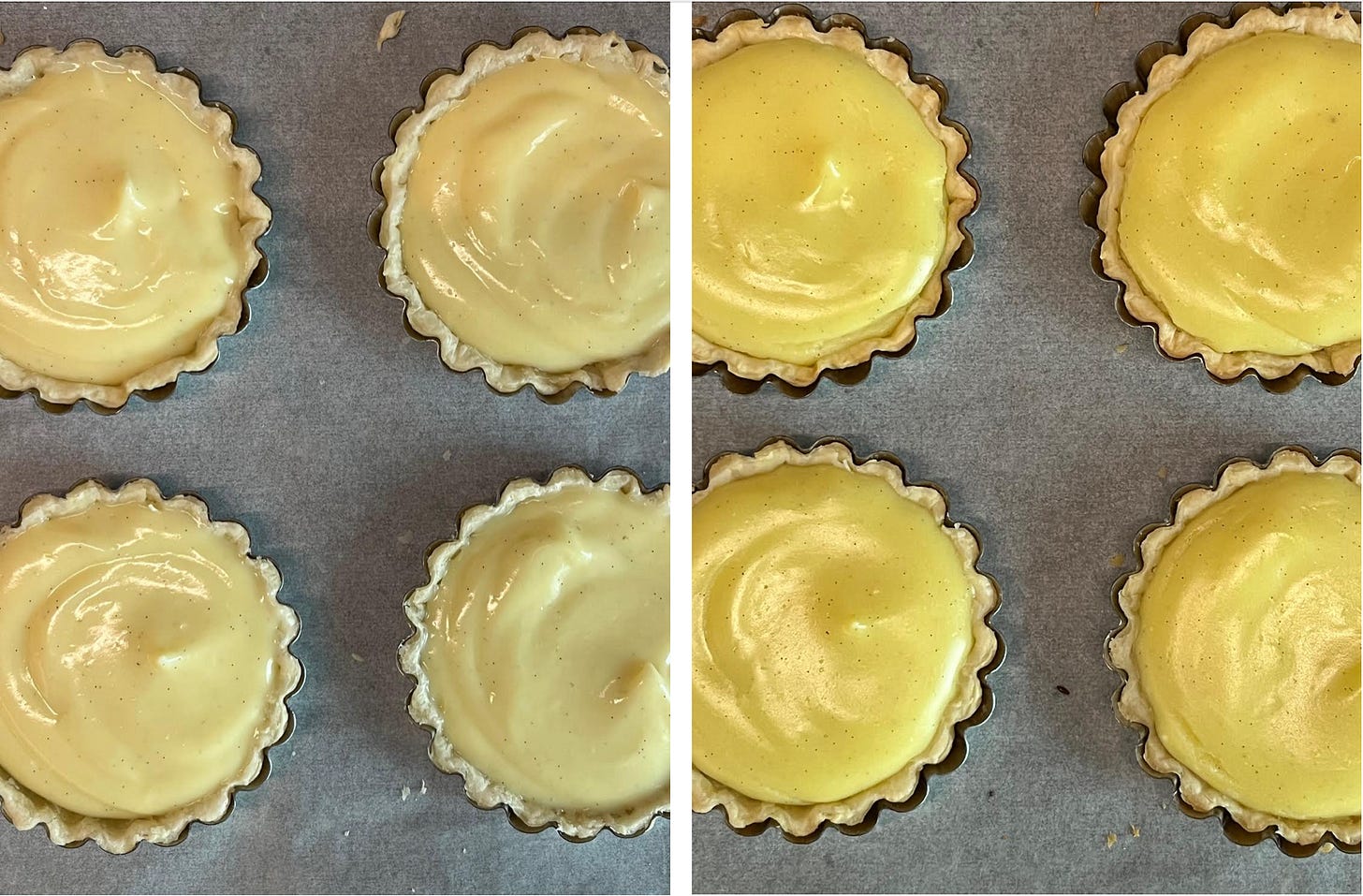

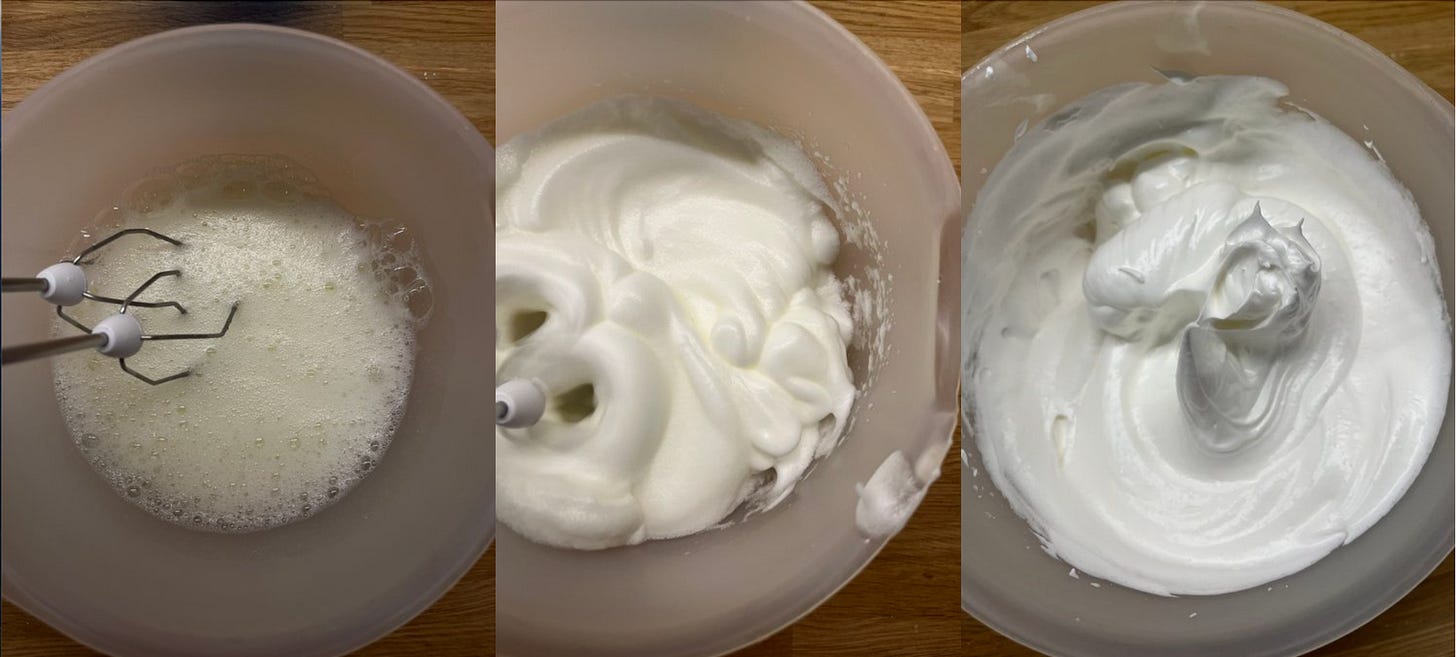
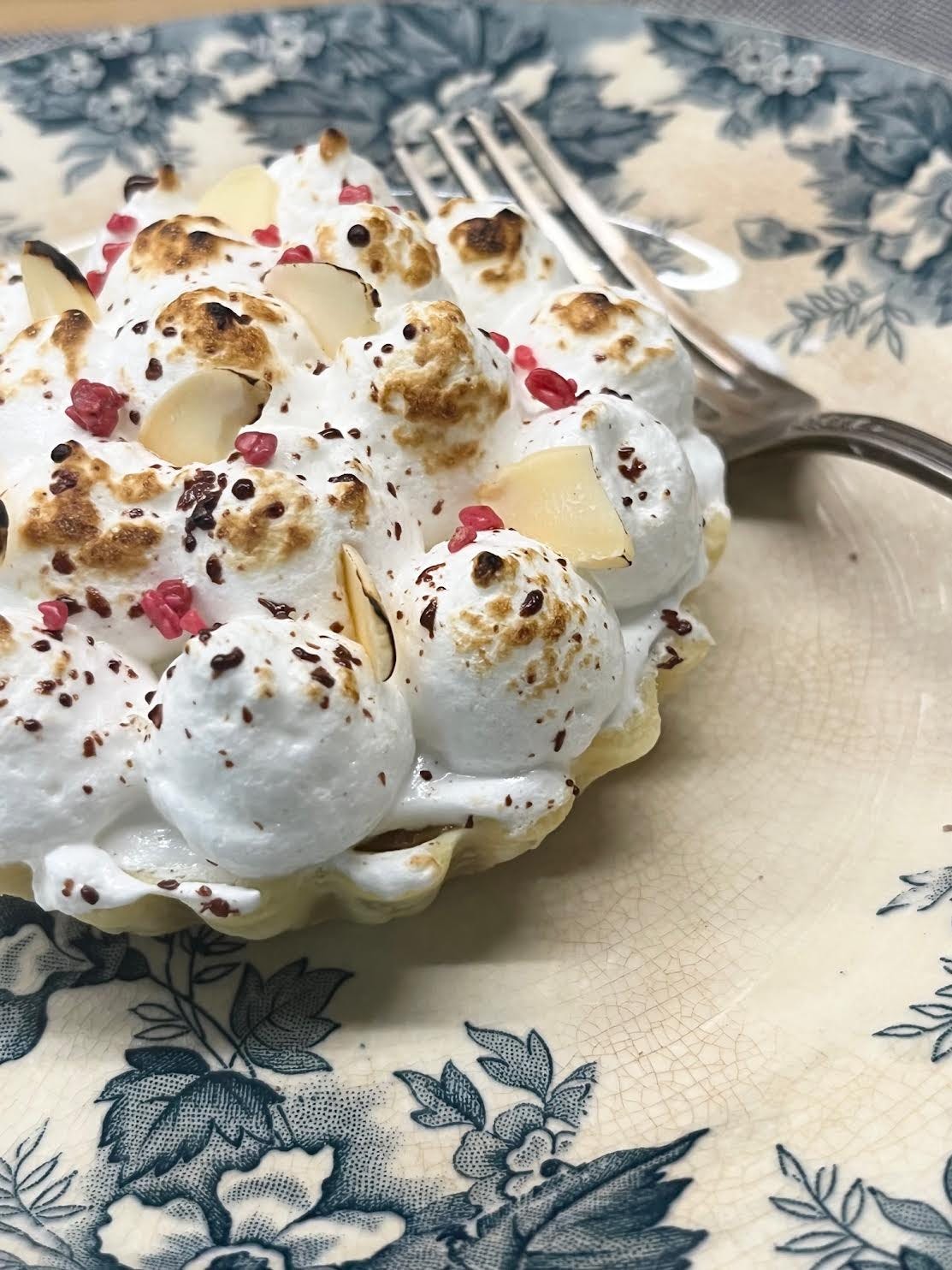
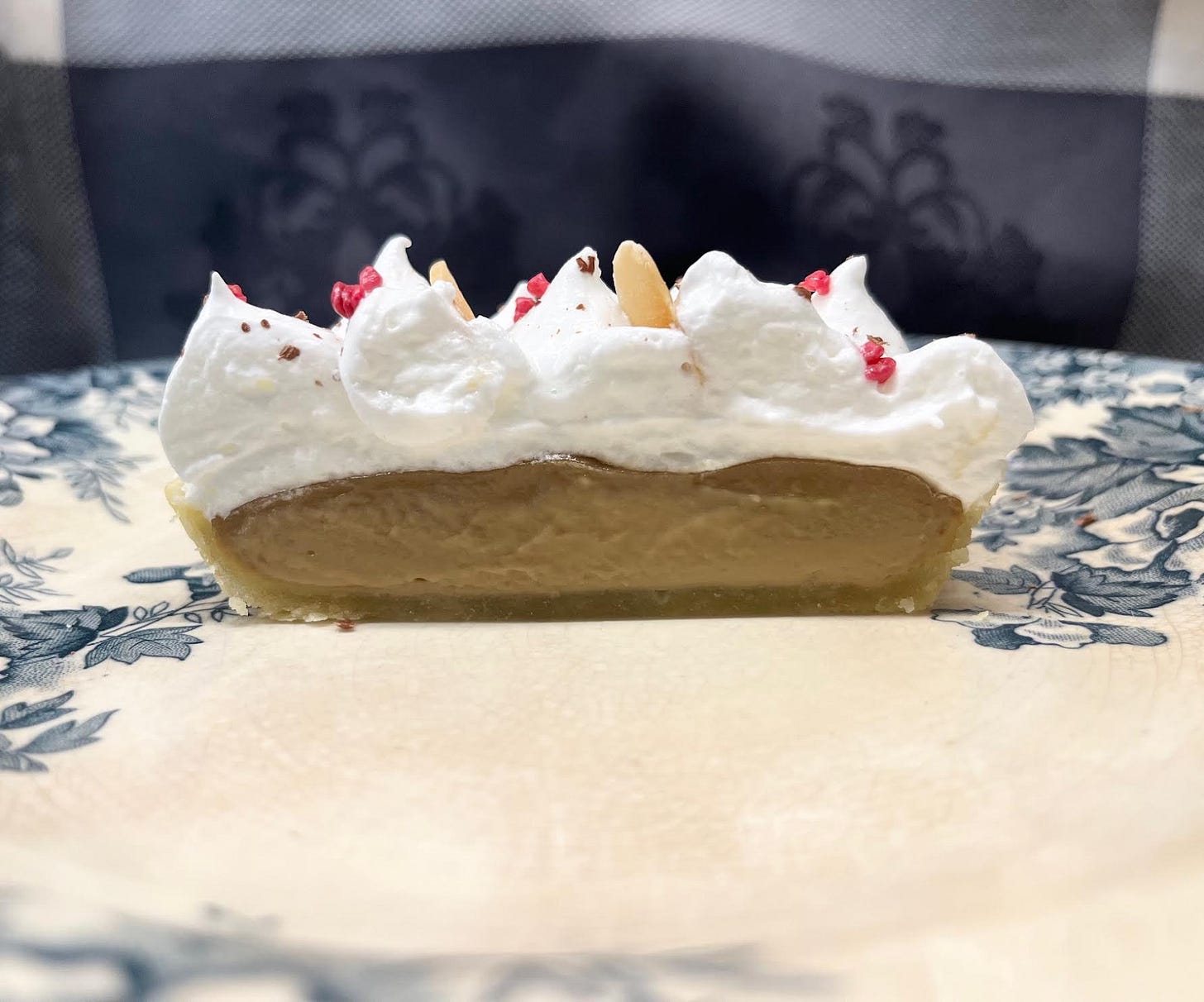
Wow, these are lovely! A forgotten French pastry... Very interesting history. You may be familiar with a very popular french drinking song called "Fanchon", that tells the story of a lovely French woman who loves food, drink, and singing. One of the few French drinking songs that isn't pornographic! (I learned these songs in French vet school).
The refrain says: "she loves to laugh and drink, she loves to sing like us, yes, like us." 🙂 https://youtu.be/jj7coEGtEi8?si=oju2UlCHIGtLvgHW
Yet another great article. Well researched and beautifully written. Thanks so much for sharing your knowledge and wisdom around matters culinary.